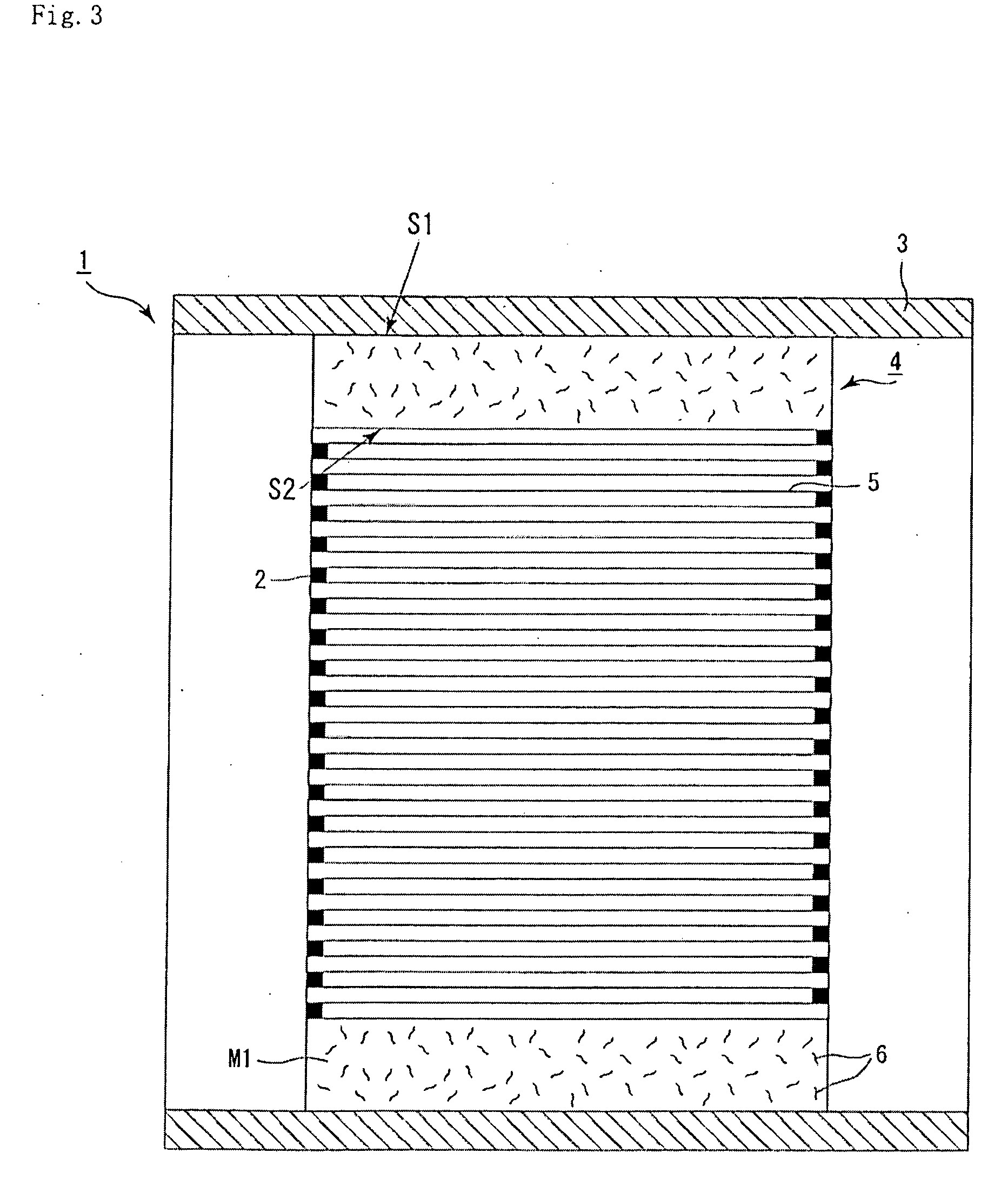Alumina-silica-based fiber, ceramic fiber, ceramic fiber complex, retaining seal material, production method thereof, and alumina fiber complex production method
a technology of ceramic fibers and aluminasilica, which is applied in the direction of machines/engines, transportation and packaging, and separation processes, etc., can solve the problems of affecting the environment and the human body, affecting the holding property and sealing property of catalyst carriers, and affecting the environment. , to achieve the effect of improving the mechanical strength, reducing the risk of degradation, and high initial face pressur
- Summary
- Abstract
- Description
- Claims
- Application Information
AI Technical Summary
Benefits of technology
Problems solved by technology
Method used
Image
Examples
first embodiment
[0415]Referring to FIGS. 1 to 3, as well as FIG. 12, the following description will be given of a catalyst converter used for an automobile exhaust gas purifying device in accordance with the first embodiment according to the fifth group of the present invention in detail.
[0416]This catalyst converter 1 in accordance with the embodiment of the fifth group of the present invention, shown in FIG. 3, is virtually the same as the catalyst converter according to the first group of the present invention, and constituted by a catalyst carrier 2, a metal shell 3 covering the outer circumference of the catalyst carrier 2, and a holding seal material 4 that is placed in a gap between the two members 2 and 3.
[0417]Here, with respect to the catalyst carrier 2 and the metal shell 3, the same members that have been explained in the catalyst converter according to the first group of the present invention may be used; therefore, the description thereof is omitted.
[0418]Moreover, with respect to the...
second embodiment
[0456]The following description will be given of a second embodiment according to the fifth group of the present invention. Here, explanations will be mainly given on points that are different from the first embodiment according to the fifth group of the present invention, and those same parts are indicated by the same reference numerals, and the description thereof is omitted.
[0457]In this case, a holding seal material 4 having the above-mentioned structure is manufactured in the following sequence. First, a spinning process is carried out in the same manner as the first embodiment according to the fifth group of the present invention to provide long fibers of precursor fibers by using a spinning stock solution of the alumina-silica based fibers 6 as a material. Next, a cutting process is carried out so that the long fibers are chopped by a guillotine cutter to form shorter fibers in a certain extent. Then, a molding process is carried out in such a manner that the short fibers are...
example 1
[0531]In example 1, first, a basic water solution of aluminum chloride (23.5% by weight), silica sol (20% by weight, silica particle size 15 nm) and polyvinyl alcohol (10% by weight) that is a fiber-drawing property applying agent were mixed to prepare a spinning stock solution. Next, the resulting spinning stock solution was condensed under vacuum at 50° C. by using an evaporator to prepare a spinning stock solution having a concentration of 38% by weight with a viscosity of 1500 Poise.
[0532]After preparation, the spinning stock solution was continuously discharged into the air through a nozzle (having a complete round shape in its cross-section) of the spinning device, and the precursor fibers thus formed were wound up while being extended.
[0533]Next, after the above-mentioned precursor fibers had been subjected to a heating step (pre-processing) at 250° C. for 30 minutes in an electric furnace that is maintained at normal pressure in a nitrogen atmosphere, these were sintered at ...
PUM
| Property | Measurement | Unit |
|---|---|---|
| Percent by mass | aaaaa | aaaaa |
| Percent by mass | aaaaa | aaaaa |
| Percent by mass | aaaaa | aaaaa |
Abstract
Description
Claims
Application Information
 Login to View More
Login to View More - R&D
- Intellectual Property
- Life Sciences
- Materials
- Tech Scout
- Unparalleled Data Quality
- Higher Quality Content
- 60% Fewer Hallucinations
Browse by: Latest US Patents, China's latest patents, Technical Efficacy Thesaurus, Application Domain, Technology Topic, Popular Technical Reports.
© 2025 PatSnap. All rights reserved.Legal|Privacy policy|Modern Slavery Act Transparency Statement|Sitemap|About US| Contact US: help@patsnap.com



